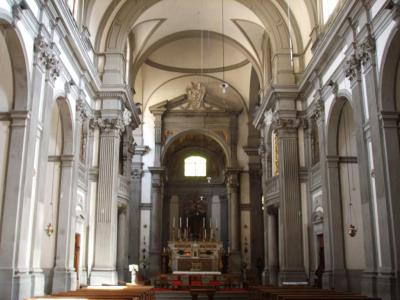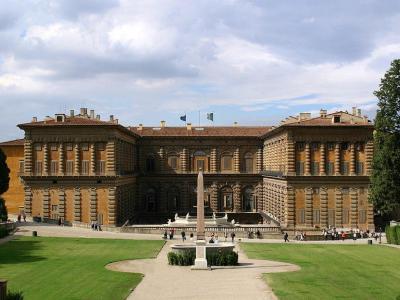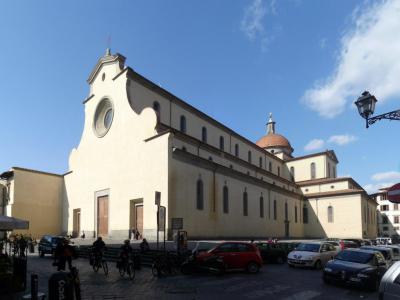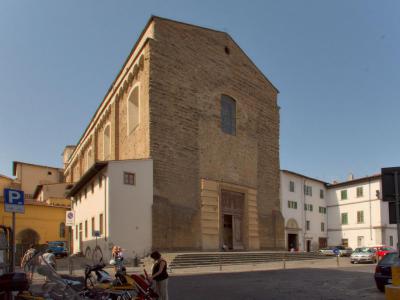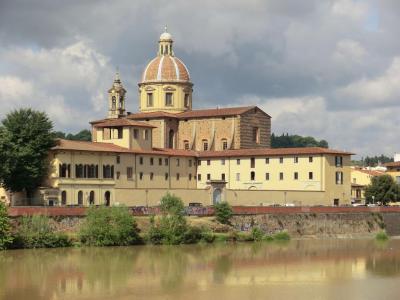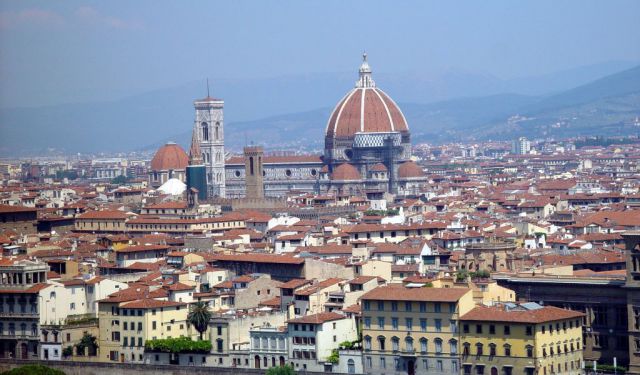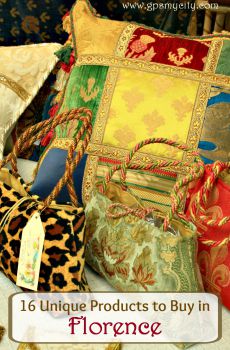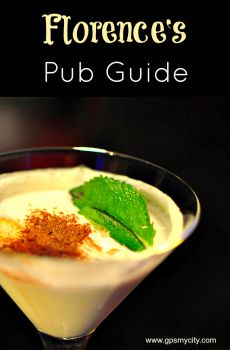
Arno South Bank Walking Tour (Self Guided), Florence
The area south of Arno river, also called Oltrarno ("Beyond the Arno"), is a quieter place but not less interesting. Here you can find the Pitti Palace whose collection of paintings is second only to the Uffizi, and the vast Boboli Gardens once enjoyed by the Medici and the royal family. One of the first and most important examples of "Italian Gardens", they later served as inspiration for many European courts.
A district of old trades and traditions, Oltrarno is best explored by walking around and discovering not only local craftsmanship, markets and typical trattorias, but also the beauty of the squares, monuments and – most of all – churches.
Right from the get-go Santa Felicita’s big draw is Jacopo Pontormo’s recently restored painting of the Deposition from the Cross, plus the special Medici balcony where the Vasari Corridor cuts across the face of the church.
Do stop by the elegant Basilica di Santo Spirito as well, to see Michelangelo’s unique nude Christ on the Cross, and to admire the superb 17th-century cloister with its lovely garden surrounded on four sides by colonnades and arches.
On the last stretch, Santa Maria del Carmine is notable for its marvelous frescoes by Masolino and Masaccio (the latter of which revolutionized Renaissance art), while San Frediano in Cestello is a beautiful example of late Baroque Tuscan architecture, combining Florentine austerity with Roman influences – and some rather unusual elements in the Florentine panorama. Great background for a photo!
This self-guided walking tour takes you to these and other wonderful places, along the way passing by charming narrow streets, prestigious antique dealers, and plenty of artisan workshops. Wear comfortable shoes and explore at your own pace!
A district of old trades and traditions, Oltrarno is best explored by walking around and discovering not only local craftsmanship, markets and typical trattorias, but also the beauty of the squares, monuments and – most of all – churches.
Right from the get-go Santa Felicita’s big draw is Jacopo Pontormo’s recently restored painting of the Deposition from the Cross, plus the special Medici balcony where the Vasari Corridor cuts across the face of the church.
Do stop by the elegant Basilica di Santo Spirito as well, to see Michelangelo’s unique nude Christ on the Cross, and to admire the superb 17th-century cloister with its lovely garden surrounded on four sides by colonnades and arches.
On the last stretch, Santa Maria del Carmine is notable for its marvelous frescoes by Masolino and Masaccio (the latter of which revolutionized Renaissance art), while San Frediano in Cestello is a beautiful example of late Baroque Tuscan architecture, combining Florentine austerity with Roman influences – and some rather unusual elements in the Florentine panorama. Great background for a photo!
This self-guided walking tour takes you to these and other wonderful places, along the way passing by charming narrow streets, prestigious antique dealers, and plenty of artisan workshops. Wear comfortable shoes and explore at your own pace!
How it works: Download the app "GPSmyCity: Walks in 1K+ Cities" from Apple App Store or Google Play Store to your mobile phone or tablet. The app turns your mobile device into a personal tour guide and its built-in GPS navigation functions guide you from one tour stop to next. The app works offline, so no data plan is needed when traveling abroad.
Arno South Bank Walking Tour Map
Guide Name: Arno South Bank Walking Tour
Guide Location: Italy » Florence (See other walking tours in Florence)
Guide Type: Self-guided Walking Tour (Sightseeing)
# of Attractions: 11
Tour Duration: 2 Hour(s)
Travel Distance: 2.4 Km or 1.5 Miles
Author: greghasleft
Sight(s) Featured in This Guide:
Guide Location: Italy » Florence (See other walking tours in Florence)
Guide Type: Self-guided Walking Tour (Sightseeing)
# of Attractions: 11
Tour Duration: 2 Hour(s)
Travel Distance: 2.4 Km or 1.5 Miles
Author: greghasleft
Sight(s) Featured in This Guide:
- Ponte Vecchio (Old Bridge)
- Chiesa di Santa Felicita (Church of St. Felicity)
- Palazzo Pitti (Pitti Palace)
- Casa Guidi (Home of Robert and Elizabeth Barrett Browning)
- Chiesa di San Felice in Piazza (Church of St. Felix)
- Museo Storia Naturale - La Specola (Museum of Natural History)
- Via Maggio (broadest street in Florence)
- Basilica di Santo Spirito (Basilica of the Holy Spirit)
- Basilica di Santa Maria del Carmine (Basilica of Our Lady of Mount Carmel)
- Chiesa di San Frediano in Cestello (Church of Saint Fridianus)
- Porta San Frediano (San Frediano Gate)
1) Ponte Vecchio (Old Bridge) (must see)
Ponte Vecchio (or The Old Bridge) in Florence appeared in documents for the first time in 996. Of all the six local bridges crossing the river Arno, it was the only one spared by the retreating Germans in 1944. Today, this Medieval stone arch bridge stands testament to what a monarch can accomplish in terms of lasting legacy.
Still lined with shops, as was commonplace in the Middle Ages, the bridge is presently occupied by jewelers, art dealers and souvenir sellers, whereas initially, its tenants were all butchers who habitually dumped rotten animal carcasses straight into the river below. That was the case until the 16th century when Grand Duke Fernandino I de' Medici demanded that all the butcher shops were replaced by goldsmiths – thus not only did he rid the bridge of its rotting stench, but also turned it into the golden-most spot in Italy.
When observing the bridge from afar, a discerning eye may notice an upper level that unveils a fascinating secret. This concealed feature is a kilometer-long tunnel connecting the Pitti Palace with the Old Palace. Historically, the tunnel provided a secure route for Duke Fernandino to move between the two palaces discreetly whenever he felt uneasy in public. Although the passageway has been closed for safety reasons since 2016, there are exciting plans by the Uffizi Gallery to reopen it.
One of the legends surrounding the bridge is it that the economic term "bankruptcy" originated right here when a money-changer who couldn't pay his debts, in punishment for his insolvency had his trading table physically broken by soldiers, so he could no longer sell anything. The table was called "banco", and thus the term "bancorotto" came into being.
Today, the Old Bridge offers a delightful stroll, especially in the evenings, if not packed end to end with thousands of tourists traversing the river over its cobblestones.
Why You Should Visit:
The sunset light here makes it a special spot to cross or watch from afar. The morning light reflecting upon the river is just as gorgeous a sight to behold and, if you come here early in the day, you may stand a pretty good chance of having this "old bridge" all to yourself!
Tip:
If you do cross the bridge, be careful with your surroundings to avoid getting pickpocketed.
Still lined with shops, as was commonplace in the Middle Ages, the bridge is presently occupied by jewelers, art dealers and souvenir sellers, whereas initially, its tenants were all butchers who habitually dumped rotten animal carcasses straight into the river below. That was the case until the 16th century when Grand Duke Fernandino I de' Medici demanded that all the butcher shops were replaced by goldsmiths – thus not only did he rid the bridge of its rotting stench, but also turned it into the golden-most spot in Italy.
When observing the bridge from afar, a discerning eye may notice an upper level that unveils a fascinating secret. This concealed feature is a kilometer-long tunnel connecting the Pitti Palace with the Old Palace. Historically, the tunnel provided a secure route for Duke Fernandino to move between the two palaces discreetly whenever he felt uneasy in public. Although the passageway has been closed for safety reasons since 2016, there are exciting plans by the Uffizi Gallery to reopen it.
One of the legends surrounding the bridge is it that the economic term "bankruptcy" originated right here when a money-changer who couldn't pay his debts, in punishment for his insolvency had his trading table physically broken by soldiers, so he could no longer sell anything. The table was called "banco", and thus the term "bancorotto" came into being.
Today, the Old Bridge offers a delightful stroll, especially in the evenings, if not packed end to end with thousands of tourists traversing the river over its cobblestones.
Why You Should Visit:
The sunset light here makes it a special spot to cross or watch from afar. The morning light reflecting upon the river is just as gorgeous a sight to behold and, if you come here early in the day, you may stand a pretty good chance of having this "old bridge" all to yourself!
Tip:
If you do cross the bridge, be careful with your surroundings to avoid getting pickpocketed.
2) Chiesa di Santa Felicita (Church of St. Felicity)
Dedicated to Saint Felicity – an early Roman martyr, this church ranks among the oldest in Florence, having possibly been founded in the 2nd century AD by Greek or Syrian merchants, the city's pioneers of Christianity. A new church was built in the 11th century and the current edifice dates from 1736–39, under design by Ferdinando Ruggieri, who turned it into a single-nave edifice.
Santa Felicita was on the path of the secret corridor that stretched from the Old Palace ("Palazzo Vecchio") to the Pitti Palace, the Medici family residence. The Medicis used to come here to attend mass from a high balcony at the back so they would not be seen by other people. However, the main reason for a visit of the interior is the amazing Italian Renaissance painting masterpiece, the "Deposition from the Cross" (1525–28) by Jacopo Pontormo, one of the early Florentine Renaissance masters in the same era as Michaelangelo.
Pontormo's picture is highly unconventional: from the quasi-angelic creatures bearing Christ's body to the billows of gorgeously colored drapery that almost engulf the scene; many of the figures seem to be standing in mid-air rather than on solid ground; and there's no trace of the cross, the thieves, soldiers or any of the other scene-setting elements usual in paintings of this subject – the only contextual feature is a solitary ghostly cloud. The bearded, cloaked figure on the right (Nicodemus) is believed to be a self-portrait of the artist.
Santa Felicita was on the path of the secret corridor that stretched from the Old Palace ("Palazzo Vecchio") to the Pitti Palace, the Medici family residence. The Medicis used to come here to attend mass from a high balcony at the back so they would not be seen by other people. However, the main reason for a visit of the interior is the amazing Italian Renaissance painting masterpiece, the "Deposition from the Cross" (1525–28) by Jacopo Pontormo, one of the early Florentine Renaissance masters in the same era as Michaelangelo.
Pontormo's picture is highly unconventional: from the quasi-angelic creatures bearing Christ's body to the billows of gorgeously colored drapery that almost engulf the scene; many of the figures seem to be standing in mid-air rather than on solid ground; and there's no trace of the cross, the thieves, soldiers or any of the other scene-setting elements usual in paintings of this subject – the only contextual feature is a solitary ghostly cloud. The bearded, cloaked figure on the right (Nicodemus) is believed to be a self-portrait of the artist.
3) Palazzo Pitti (Pitti Palace) (must see)
The Pitti Palace is yet another architectural marvel in Florence to miss which would truly be a regrettable omission. Its main highlight is undoubtedly Renaissance architecture, coupled with the spectacular gardens every turn of which breathe new adventure.
Today the enormous palace brings under one roof several museums, whereas originally it was the official (last) residence of the incredibly powerful Medici family from the 16th to the 18th century. First built in the second half of the 15th century for Luca Pitti, it was still unfinished at the time of his death in 1472. In the year 1550, the palace was bought by Eleonora di Toledo, wife of the Grand Duke Cosimo I de' Medici. When the Medici dynasty came to an end, the property fell into the hands of the House of Lorraine and, in the early 19th century, Napoleon Bonaparte used it as a power base during his reign over Italy.
Everything about this palace oozes class, be it the Palatine Gallery with over 500 paintings, or the lavish Royal Apartments of the Medicis, or the "Medici Treasury" with the priceless 15th-century silver, or the Costumes Gallery, or the Porcelain and Carriages Museums. The impressive painted ceilings, walls and ground decorations project the image of a private royal residence despite the fact since 1919, the palace itself and everything inside have been the property of the Italian people, nowadays attracting over 5 million visitors each year.
***MEDICI LANDMARK***
Here you will find perhaps the greatest concentration of all things Medici in Florence! The artwork formerly owned by the family, and displayed elsewhere, may possibly dwarf the contents of the Pitti in terms of value, but the palace has an incredible array of furnishings and interior decoration!
Tip:
With a combined full ticket to the Pitti Museums and Gardens, you can enjoy two days of access. If you have ample time, consider spending around 3hrs leisurely exploring the gardens, but don't forget essential items like a hat and a bottle of water to stay comfortable.
To avoid lengthy queues at the palace, opting for a guided tour is a wise choice. Although there is an associated cost, the tour offers the advantage of skipping the line, saving you valuable time in Florence. Moreover, knowledgeable guides will lead you directly to the highlights of the collections, ensuring you don't miss any important exhibits that might be challenging to locate on your own. Embracing this option is a smart move for an efficient and fulfilling visit to the Pitti Palace.
Today the enormous palace brings under one roof several museums, whereas originally it was the official (last) residence of the incredibly powerful Medici family from the 16th to the 18th century. First built in the second half of the 15th century for Luca Pitti, it was still unfinished at the time of his death in 1472. In the year 1550, the palace was bought by Eleonora di Toledo, wife of the Grand Duke Cosimo I de' Medici. When the Medici dynasty came to an end, the property fell into the hands of the House of Lorraine and, in the early 19th century, Napoleon Bonaparte used it as a power base during his reign over Italy.
Everything about this palace oozes class, be it the Palatine Gallery with over 500 paintings, or the lavish Royal Apartments of the Medicis, or the "Medici Treasury" with the priceless 15th-century silver, or the Costumes Gallery, or the Porcelain and Carriages Museums. The impressive painted ceilings, walls and ground decorations project the image of a private royal residence despite the fact since 1919, the palace itself and everything inside have been the property of the Italian people, nowadays attracting over 5 million visitors each year.
***MEDICI LANDMARK***
Here you will find perhaps the greatest concentration of all things Medici in Florence! The artwork formerly owned by the family, and displayed elsewhere, may possibly dwarf the contents of the Pitti in terms of value, but the palace has an incredible array of furnishings and interior decoration!
Tip:
With a combined full ticket to the Pitti Museums and Gardens, you can enjoy two days of access. If you have ample time, consider spending around 3hrs leisurely exploring the gardens, but don't forget essential items like a hat and a bottle of water to stay comfortable.
To avoid lengthy queues at the palace, opting for a guided tour is a wise choice. Although there is an associated cost, the tour offers the advantage of skipping the line, saving you valuable time in Florence. Moreover, knowledgeable guides will lead you directly to the highlights of the collections, ensuring you don't miss any important exhibits that might be challenging to locate on your own. Embracing this option is a smart move for an efficient and fulfilling visit to the Pitti Palace.
4) Casa Guidi (Home of Robert and Elizabeth Barrett Browning)
Casa Guidi s a writer's house museum located in the 15th-century Palazzo Guidi at Piazza San Felice, 8, near the southern end of the Pitti Palace in Florence. A center of British society in Florence, the space was inhabitated by Robert and Elizabeth Barrett Browning from 1847 (shortly after their clandestine marriage) until Elizabeth's passing in 1861. She affectionately named the apartment 'Casa Guidi' to transform "a mere palace into a home". Today, it stands as a shrine to Elizabeth's memory, where she penned much of her beloved poetry, including, naturally enough, her notable 1851 collection, "Casa Guidi Windows."
After Mrs. Browning's death, her son, Robert, continued to live here until 1912. Eventually, the apartment was bought by several Browning enthusiasts – although, by that time, it retained hardly any furniture or paintings. The Browning Society in New York restored it, before giving it to Eton College which undertook further work so that the building could be used as a study centre. Today, it is part of The Eton College Collections but is administered by the Landmark Trust, who also look after the apartment above the one where John Keats died in Rome. When not being used by Eton boys, the property is available for holiday lets booked through the Landmark Trust.
After Mrs. Browning's death, her son, Robert, continued to live here until 1912. Eventually, the apartment was bought by several Browning enthusiasts – although, by that time, it retained hardly any furniture or paintings. The Browning Society in New York restored it, before giving it to Eton College which undertook further work so that the building could be used as a study centre. Today, it is part of The Eton College Collections but is administered by the Landmark Trust, who also look after the apartment above the one where John Keats died in Rome. When not being used by Eton boys, the property is available for holiday lets booked through the Landmark Trust.
5) Chiesa di San Felice in Piazza (Church of St. Felix)
Located on the south bank of the River Arno, just west of the Pitti Palace, this church dates back to 1066, featuring a distinctively Gothic interior and a Renaissance façade attributed to Michelozzo. In 1153, it came under the control of the Benedictines from the monastery of San Silvestro in Nonantola, who decided to expand it in the mid-14th century. It was during this period that the five single-lancet windows with pointed arches were added, still visible on the exterior wall of the church. Also from this period is the lunette fresco on the sixth altar on the left, attributed to the Maestro del Bargello, depicting the Madonna and Child, Saint James the Greater, Pope Sylvester, and the abbot of Nonantola (circa 1365). The presence of the prestigious Benedictine abbot as the patron adds significant artistic and historical importance to the fresco.
The side altars house works by various important artists. These include the "Apparition of the Madonna to Saint Hyacinth" and "St. Peter Martyr" by Empoli, signed and dated 1595; "Madonna and Child" attributed to Starnina (1409-13); Polychrome terracotta "Deposition" attributed to Fra Ambrogio della Robbia (circa 1510); "Madonna and Saints" by Ridolfo del Ghirlandaio (1520); and the fresco "Madonna della Cintola and Saints" by Bicci di Lorenzo. The side chapels (created in the 17th century) feature paintings by Salvator Rosa (fifth altar on the left), Jacopo Chiavistelli (second altar on the left), Ottavio Vannini (after the fourth altar on the right), Valerio Marucelli (fourth altar on the left), and a fresco by Giovanni da San Giovanni, completed by the Volterrano, depicting Saint Felice aiding Saint Massimo on the seventh altar on the left.
One notable artwork is the "Last Supper" painting by Matteo Rosselli (circa 1610-1620), which originated from the destroyed monastery of San Pietro Martire.
The side altars house works by various important artists. These include the "Apparition of the Madonna to Saint Hyacinth" and "St. Peter Martyr" by Empoli, signed and dated 1595; "Madonna and Child" attributed to Starnina (1409-13); Polychrome terracotta "Deposition" attributed to Fra Ambrogio della Robbia (circa 1510); "Madonna and Saints" by Ridolfo del Ghirlandaio (1520); and the fresco "Madonna della Cintola and Saints" by Bicci di Lorenzo. The side chapels (created in the 17th century) feature paintings by Salvator Rosa (fifth altar on the left), Jacopo Chiavistelli (second altar on the left), Ottavio Vannini (after the fourth altar on the right), Valerio Marucelli (fourth altar on the left), and a fresco by Giovanni da San Giovanni, completed by the Volterrano, depicting Saint Felice aiding Saint Massimo on the seventh altar on the left.
One notable artwork is the "Last Supper" painting by Matteo Rosselli (circa 1610-1620), which originated from the destroyed monastery of San Pietro Martire.
6) Museo Storia Naturale - La Specola (Museum of Natural History)
Editor's Note: Currently closed for refurbishment works, this museum is expected to reopen sometime in 2023.
Amidst the historical churches and architectural marvels surrounding Florence is the oldest science museums in Europe. Focused on Zoology and Natural History, it was established by the Grand Duke Pietro Leopoldo di Lorena, who envisioned a museum that would be open to the public and purchased a block of buildings very close to the Pitti Palace to serve this purpose. The museum was inaugurated in 1775 and, up until the 19th century, was the only scientific museum in the world with open admission, opening hours, guided tours and museum curators.
Spanning across 34 rooms, La Specola showcases an extensive array of exhibits that encompass fossils, minerals, natural resources, animal specimens, exotic plants, and rare books. The collection includes artifacts dating back to the 14th and 15th centuries, reflecting the passion and collecting tradition of the Medici family, who sourced treasures from around the globe.
Notably, the museum's most prized possession is its collection of anatomical wax models, which were introduced as a revolutionary art form by Ludovico Cigoli. These intricately crafted wax models were specifically designed for teaching anatomy, providing a valuable educational tool that eliminated the need to dissect human cadavers.
Amidst the historical churches and architectural marvels surrounding Florence is the oldest science museums in Europe. Focused on Zoology and Natural History, it was established by the Grand Duke Pietro Leopoldo di Lorena, who envisioned a museum that would be open to the public and purchased a block of buildings very close to the Pitti Palace to serve this purpose. The museum was inaugurated in 1775 and, up until the 19th century, was the only scientific museum in the world with open admission, opening hours, guided tours and museum curators.
Spanning across 34 rooms, La Specola showcases an extensive array of exhibits that encompass fossils, minerals, natural resources, animal specimens, exotic plants, and rare books. The collection includes artifacts dating back to the 14th and 15th centuries, reflecting the passion and collecting tradition of the Medici family, who sourced treasures from around the globe.
Notably, the museum's most prized possession is its collection of anatomical wax models, which were introduced as a revolutionary art form by Ludovico Cigoli. These intricately crafted wax models were specifically designed for teaching anatomy, providing a valuable educational tool that eliminated the need to dissect human cadavers.
7) Via Maggio (broadest street in Florence)
Via Maggio, situated in the Oltrarno neighborhood, is a delightful street renowned for its broadness, earning it the title of the broadest street in Florence. Its origins trace back to the Renaissance era, when it was known as "Via Maggiore," meaning High or Broad Street in English. Along its length, visitors can marvel at the captivating palaces and elegant buildings that showcase the city's architectural heritage. Immerse yourself in the allure of the past as you admire the intricate details, well-preserved structures, and charming facades that transport you to another era.
In its earlier days, Via Maggio served as a bustling commercial thoroughfare, and today it retains a vibrant atmosphere reminiscent of an open-air museum. The street is lined with a plethora of antique shops and art galleries, proudly displaying their offerings for passersby. A leisurely stroll reveals a treasure trove of artistic wonders, including oil paintings, marble statues, sculptures, tapestries, china figures, furniture, lamps, and weaponry from the 16th to the 18th centuries. Whether you're a collector or simply fascinated by the arts, Via Maggio promises a captivating experience as you peruse these unique and authentic pieces.
Beyond the art and antiquities, Via Maggio offers a charming assortment of cafes, restaurants, and artisan workshops. Indulge in the delectable flavors of Tuscan cuisine or unwind with a cup of coffee while soaking in the local ambiance. The street beckons you to take a break from your sightseeing adventures and enjoy a leisurely meal or snack in one of its inviting establishments.
In its earlier days, Via Maggio served as a bustling commercial thoroughfare, and today it retains a vibrant atmosphere reminiscent of an open-air museum. The street is lined with a plethora of antique shops and art galleries, proudly displaying their offerings for passersby. A leisurely stroll reveals a treasure trove of artistic wonders, including oil paintings, marble statues, sculptures, tapestries, china figures, furniture, lamps, and weaponry from the 16th to the 18th centuries. Whether you're a collector or simply fascinated by the arts, Via Maggio promises a captivating experience as you peruse these unique and authentic pieces.
Beyond the art and antiquities, Via Maggio offers a charming assortment of cafes, restaurants, and artisan workshops. Indulge in the delectable flavors of Tuscan cuisine or unwind with a cup of coffee while soaking in the local ambiance. The street beckons you to take a break from your sightseeing adventures and enjoy a leisurely meal or snack in one of its inviting establishments.
8) Basilica di Santo Spirito (Basilica of the Holy Spirit)
The Santo Spirito is another Florence building credited to the brilliant Renaissance architect – Filippo Brunelleschi. At first glance, with its plain exteriors, it may not look very impressive, but the true beauty and design can be appreciated in the interiors featuring numerous Baroque embellishments and an impressive Baldachin with polychrome marbles over the high-raised altar. The side chapels, in the form of niches all the same size (forty in all), run along the entire perimeter of the space and contain a noteworthy amount of artworks by Renaissance artists such as Sansovino and Rosselli. Some of the pieces that have been restored are fantastic in color and definition.
The two cloisters – accessed for a small fee – have walls decorated with a great number of tombstones and impressive Late Gothic frescoes, as well as a collection of sculptures from the 11th-15th centuries, including two low reliefs by Donatello, a high relief by Jacopo della Quercia (Madonna with Child), and two marble sculptures by Tino da Camaino (1320–22).
***MICHELANGELO'S MASTERPIECES***
In a side chapel is a very special find—a wooden crucifix sculpted by a young Michelangelo before he relocated to Rome. Aged seventeen, he was allowed to make anatomical studies on the corpses coming from the convent's hospital; in exchange, he sculpted the crucifix which was placed over the high altar. Today the crucifix is in the octagonal sacristy that can be reached from the west aisle of the church. Also, don't miss the copies of his "Pietà" (1549) and "Christ" (1579).
Tip:
Be sure to visit the "Fondazione Salvatore Romano" museum to the side of the Basilica in the old refectory.
The two cloisters – accessed for a small fee – have walls decorated with a great number of tombstones and impressive Late Gothic frescoes, as well as a collection of sculptures from the 11th-15th centuries, including two low reliefs by Donatello, a high relief by Jacopo della Quercia (Madonna with Child), and two marble sculptures by Tino da Camaino (1320–22).
***MICHELANGELO'S MASTERPIECES***
In a side chapel is a very special find—a wooden crucifix sculpted by a young Michelangelo before he relocated to Rome. Aged seventeen, he was allowed to make anatomical studies on the corpses coming from the convent's hospital; in exchange, he sculpted the crucifix which was placed over the high altar. Today the crucifix is in the octagonal sacristy that can be reached from the west aisle of the church. Also, don't miss the copies of his "Pietà" (1549) and "Christ" (1579).
Tip:
Be sure to visit the "Fondazione Salvatore Romano" museum to the side of the Basilica in the old refectory.
9) Basilica di Santa Maria del Carmine (Basilica of Our Lady of Mount Carmel)
The Church of Santa Maria del Carmine stands as a sanctuary dedicated to Our Lady of Mount Carmel, a title bestowed upon the Blessed Virgin Mary. Originally constructed in the late 13th century, what remains today of the church's exterior is a testament to its Romanesque-Gothic roots. However, the church's history took a dramatic turn in the 18th century when a fire nearly devastated the entire structure, miraculously sparing the renowned Brancacci Chapel and its Renaissance frescoes.
The Brancacci Chapel holds great significance as a monument to the emergence of the Italian Renaissance. The fresco that adorns the wall of the basilica is among the most influential and pivotal works in the history of Italian art. Its creation began in 1425, when Masolino da Panicale was commissioned to work on three walls of the chapel. Masolino enlisted the assistance of his young associate, the 21-year-old Masaccio, who later took charge of the project. Masaccio's profound influence on the frescoes is evident and is considered one of the finest accomplishments of his career. Unfortunately, Masaccio's premature death in 1428 left the frescoes neglected for 60 years until Filippino Lippi arrived and made significant contributions to the chapel.
The basilica also includes the Corsini Chapel, commissioned by the Corsini family, one of the wealthiest families in Florence during the 17th and 18th centuries. Built in 1675, the chapel serves as the resting place for the remains of Andrea Corsini (1301–1374), a member of the Corsini family who became a Carmelite friar and the Bishop of Fiesole, canonized in 1629. Designed in the popular Baroque style of the time by architect Silvani, the chapel features a small dome that was frescoed by Luca Giordano in 1682. The intricate Italian Rococo ceiling, a highlight of the chapel, is the work of Giovanni Domenico Ferretti, one of the most esteemed 18th-century artists in Florence.
The Brancacci Chapel holds great significance as a monument to the emergence of the Italian Renaissance. The fresco that adorns the wall of the basilica is among the most influential and pivotal works in the history of Italian art. Its creation began in 1425, when Masolino da Panicale was commissioned to work on three walls of the chapel. Masolino enlisted the assistance of his young associate, the 21-year-old Masaccio, who later took charge of the project. Masaccio's profound influence on the frescoes is evident and is considered one of the finest accomplishments of his career. Unfortunately, Masaccio's premature death in 1428 left the frescoes neglected for 60 years until Filippino Lippi arrived and made significant contributions to the chapel.
The basilica also includes the Corsini Chapel, commissioned by the Corsini family, one of the wealthiest families in Florence during the 17th and 18th centuries. Built in 1675, the chapel serves as the resting place for the remains of Andrea Corsini (1301–1374), a member of the Corsini family who became a Carmelite friar and the Bishop of Fiesole, canonized in 1629. Designed in the popular Baroque style of the time by architect Silvani, the chapel features a small dome that was frescoed by Luca Giordano in 1682. The intricate Italian Rococo ceiling, a highlight of the chapel, is the work of Giovanni Domenico Ferretti, one of the most esteemed 18th-century artists in Florence.
10) Chiesa di San Frediano in Cestello (Church of Saint Fridianus)
Take your time to wander aimlessly in neighborhoods that are typically overlooked by tourists. San Frediano may not have major attractions, but it offers plenty of opportunities to immerse yourself in the local atmosphere. Just across the expansive Piazza del Carmine, you'll find Borgo San Frediano, the main street of a charming district known for its working-class heritage.
As you stroll down this street, you'll come across the Church of Saint Fridianus, characterized by its unfinished rough stone façade. However, step inside, and you'll be captivated by one of Florence's finest Baroque interiors. The frescoed dome above the main altar, created by Antonio Domenico Gabbiani, is a sight to behold. Don't miss the 14th-century masterpiece "Madonna of the Smile" and Bernardino Poccetti's "Last Supper" (circa 1600) in the refectory.
Tip:
This part of the city is a gastronomic haven with numerous delightful eateries lining the streets. One place worth visiting is Gelateria La Carraia, which was opened in 1990 by twin brothers Massimo and Roberto and has since become a beloved spot for both locals and travelers. Make sure to try their artisanal ice cream, prepared daily on-site at their San Frediano store. And if you're a fan of cheesecake ice-cream, it's a must-try delicacy there.
As you stroll down this street, you'll come across the Church of Saint Fridianus, characterized by its unfinished rough stone façade. However, step inside, and you'll be captivated by one of Florence's finest Baroque interiors. The frescoed dome above the main altar, created by Antonio Domenico Gabbiani, is a sight to behold. Don't miss the 14th-century masterpiece "Madonna of the Smile" and Bernardino Poccetti's "Last Supper" (circa 1600) in the refectory.
Tip:
This part of the city is a gastronomic haven with numerous delightful eateries lining the streets. One place worth visiting is Gelateria La Carraia, which was opened in 1990 by twin brothers Massimo and Roberto and has since become a beloved spot for both locals and travelers. Make sure to try their artisanal ice cream, prepared daily on-site at their San Frediano store. And if you're a fan of cheesecake ice-cream, it's a must-try delicacy there.
11) Porta San Frediano (San Frediano Gate)
Porta San Frediano is a well-preserved gateway located at the western end of Borgo, the main street of the San Frediano district in Florence. Finished in 1332, it stands as a testament to the city's medieval past, representing one of the finest examples of the 14th-century city walls that once encircled Florence.
Originally constructed in the 12th century, Porta San Frediano served as an important entry point for travelers and goods coming from Pisa and the western regions of Tuscany. Its name is derived from the nearby San Frediano church, while its architecture reflects the military fortifications of the medieval era, featuring a central arch flanked by two smaller arches for pedestrian traffic. Above the arches, a defensive structure called a machicolation provided openings for dropping projectiles on attackers.
Throughout its history, Porta San Frediano witnessed significant events. During the Middle Ages, the gate played a crucial role in defending the city, enduring sieges and attacks. It also served as a symbol of Florence's power and control over its surrounding territories. A depiction of the gate in 1494 can be seen in a painting by Filippino Lippi, namely the "Madonna and Child with Saint John among Saints Martin of Tours and Catherine of Alexandria" found in the Nerli Chapel of Florence's Santo Spirito church.
With the expansion of Florence beyond its medieval boundaries, Porta San Frediano gradually lost its strategic military importance. Unlike numerous gateways that were destroyed during the demolition of Florence's city walls in the 19th century, the San Frediano Gate was fortunate to be spared from such fate. It proudly retains its original large wooden and metal doors, which add to its historical and architectural value.
Tip:
Make sure not to overlook Trattoria Sabatino (Mon-Fri: 12–2:30pm, 7:15–10pm), a roomy and well-lit dining hall that has retained its original charm since its establishment in 1956. Charging astonishingly affordable prices, this family-owned eatery offers a genuine experience with a straightforward menu. An excellent spot to observe locals relishing their meals, it is conveniently located just outside the San Frediano Gate, a 15-minute walk from the Old Bridge ("Ponte Vecchio"), at Via Pisana 2/R, and will be a delightful reward for those who have embarked on this Arno South Bank Walking Tour.
Originally constructed in the 12th century, Porta San Frediano served as an important entry point for travelers and goods coming from Pisa and the western regions of Tuscany. Its name is derived from the nearby San Frediano church, while its architecture reflects the military fortifications of the medieval era, featuring a central arch flanked by two smaller arches for pedestrian traffic. Above the arches, a defensive structure called a machicolation provided openings for dropping projectiles on attackers.
Throughout its history, Porta San Frediano witnessed significant events. During the Middle Ages, the gate played a crucial role in defending the city, enduring sieges and attacks. It also served as a symbol of Florence's power and control over its surrounding territories. A depiction of the gate in 1494 can be seen in a painting by Filippino Lippi, namely the "Madonna and Child with Saint John among Saints Martin of Tours and Catherine of Alexandria" found in the Nerli Chapel of Florence's Santo Spirito church.
With the expansion of Florence beyond its medieval boundaries, Porta San Frediano gradually lost its strategic military importance. Unlike numerous gateways that were destroyed during the demolition of Florence's city walls in the 19th century, the San Frediano Gate was fortunate to be spared from such fate. It proudly retains its original large wooden and metal doors, which add to its historical and architectural value.
Tip:
Make sure not to overlook Trattoria Sabatino (Mon-Fri: 12–2:30pm, 7:15–10pm), a roomy and well-lit dining hall that has retained its original charm since its establishment in 1956. Charging astonishingly affordable prices, this family-owned eatery offers a genuine experience with a straightforward menu. An excellent spot to observe locals relishing their meals, it is conveniently located just outside the San Frediano Gate, a 15-minute walk from the Old Bridge ("Ponte Vecchio"), at Via Pisana 2/R, and will be a delightful reward for those who have embarked on this Arno South Bank Walking Tour.
Walking Tours in Florence, Italy
Create Your Own Walk in Florence
Creating your own self-guided walk in Florence is easy and fun. Choose the city attractions that you want to see and a walk route map will be created just for you. You can even set your hotel as the start point of the walk.
Florence Food Tour
Food is one of the great Florentine passions, and the great thing about having a delicious authentic Tuscan meal, a snack, delicatessen, or a quality gelato here – besides the abundant variety – is not having to spend a lot of money for it.
In general, the “osterias” and the eateries nestled in Sant’Ambrogio Market will offer cheaper and more casual food with an emphasis on home... view more
Tour Duration: 2 Hour(s)
Travel Distance: 2.6 Km or 1.6 Miles
In general, the “osterias” and the eateries nestled in Sant’Ambrogio Market will offer cheaper and more casual food with an emphasis on home... view more
Tour Duration: 2 Hour(s)
Travel Distance: 2.6 Km or 1.6 Miles
Duomo Walking Tour
Located in the very heart of historic Florence, the Duomo area is deservedly considered the city’s religious and civic center, replete with numerous landmarks. Piazza del Duomo and Piazza della Signoria, the two most important squares in the city, are steeped in history and the sights and activities found here are truly endless.
The most prominent of these, undoubtedly, is the breathtaking... view more
Tour Duration: 2 Hour(s)
Travel Distance: 2.8 Km or 1.7 Miles
The most prominent of these, undoubtedly, is the breathtaking... view more
Tour Duration: 2 Hour(s)
Travel Distance: 2.8 Km or 1.7 Miles
Michelangelo's Masterpieces Walking Tour
Michelangelo spent over 20 years of his life in Florence – the birthplace of the Renaissance – during which time he created some of the most beautiful masterpieces the city had ever seen. The most famous of them – the David – was larger than life, and brought a larger-than-life image to the artist. No amount of photos or copies of the statue will do it justice, so to see it with your own... view more
Tour Duration: 2 Hour(s)
Travel Distance: 4.0 Km or 2.5 Miles
Tour Duration: 2 Hour(s)
Travel Distance: 4.0 Km or 2.5 Miles
Medici Landmarks Walking Tour
The Medici family helped to establish Florence as the single most important art capital of Renaissance Europe. In order to prove wealth and power, they built numerous palaces, libraries, churches, chapels and personal residences. The Medicis were big lovers of art and they acquired huge, expensive collections, as well as supporting many sculptors and painters of the time.
Designed by... view more
Tour Duration: 1 Hour(s)
Travel Distance: 2.7 Km or 1.7 Miles
Designed by... view more
Tour Duration: 1 Hour(s)
Travel Distance: 2.7 Km or 1.7 Miles
Florence Introduction Walking Tour
The city of Florence was founded by Julius Caesar in 59 BC as a settlement for veteran soldiers. It was built initially in the style of an army garrison – with main streets intersecting at today's Piazza della Repubblica. The original name, Fluentia, stems from its location between the two rivers; later, it was renamed Florentia, which means “flowering” or “flourishing”.
The... view more
Tour Duration: 2 Hour(s)
Travel Distance: 4.1 Km or 2.5 Miles
The... view more
Tour Duration: 2 Hour(s)
Travel Distance: 4.1 Km or 2.5 Miles
Florence's Hidden Art Treasures
The “Cradle of the Renaissance,” Florence is one of Europe’s most beautiful and busiest destinations, home to some of the world's greatest pieces of art and architecture. The iconic masters like Giotto, Botticelli, Raphael and Michelangelo, as well as their somewhat less-known but equally talented counterparts, such as Ghirlandaio, Sangallo and Castagno, have blessed this city with... view more
Tour Duration: 2 Hour(s)
Travel Distance: 3.2 Km or 2 Miles
Tour Duration: 2 Hour(s)
Travel Distance: 3.2 Km or 2 Miles
Useful Travel Guides for Planning Your Trip
Florence's Tasty Coffee Shop Guide
The caffe scene throughout Italy is an important factor of everyday life. People will pop in to their favorite bar on their way to work for a quick espresso breakfast with a pastry, they’ll grab a slice of pizza for lunch or drop by for an aperitivo before dining out and take a peaceful digestivo...
Souvenir Shopping Guide: 16 Unique Products to Buy in Florence
Compared to other Italian "grands" like Rome, Venice, or Milan, Florence is relatively less-known to an outsider for any local products, save, perhaps, Florentine mosaics and Fiorentina FC. Fortunately, there are tonnes of locally-originated things that this Italian city is rightfully...
Top 14 Pubs in Florence
Florence, the city of art and beauty has no problem in mastering the art of the nightlife as well. Local pubs are very popular and appreciated among the Florentines and the tourists. Locals and native English speakers that study or live in the city cannot wait to welcome tourists in their cozy...
The Most Popular Cities
/ view all

